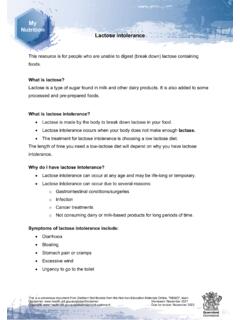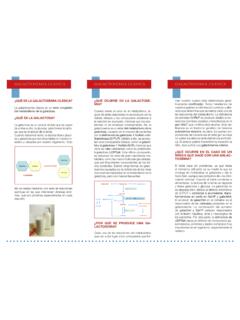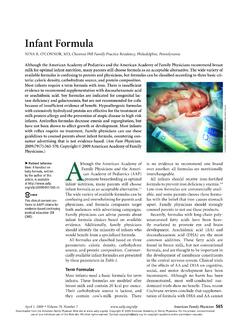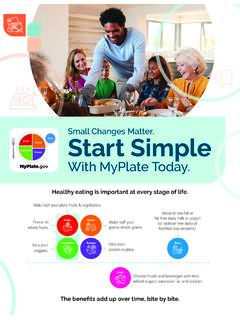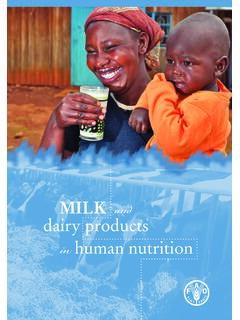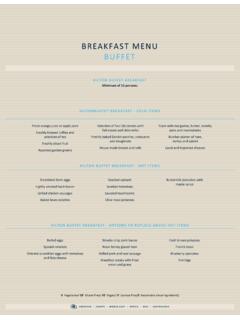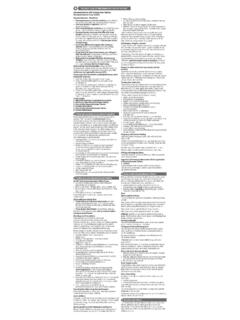Transcription of MILK and dairy products
1 milk human nutritiondairy productsinandMILK human nutritiondairy productsinandEllen Muehlhoff Senior Officer Nutrition DivisionAnthony Bennett Livestock Industry Officer Rural Infrastructure and Agro-Industries DivisionDeirdre McMahon Consultant Nutrition DivisionTechnical EditorsFOOD AND AGRICULTURE ORGANIZATION OF THE UNITED NATIONSRome, 2013 Cover photo credits front: EADD/Neil Thomas (top), FAO/A. Conti (bottom) back: ILRI/Apollo Habtamu (top), courtesy of Heifer International (mid), World Bank/Ray Witlin (bottom)The designations employed and the presentation of material in this information product do not imply the expression of any opinion whatsoever on the part of the Food and Agriculture Organization of the United Nations (FAO) concerning the legal or development status of any country, territory, city or area or of its authorities, or concerning the delimitation of its frontiers or boundaries.
2 The mention of specific companies or products of manufacturers, whether or not these have been patented, does not imply that these have been endorsed or recommended by FAO in preference to others of a similar nature that are not views expressed in this information product are those of the author(s) and do not necessarily reflect the views or policies of 978-92-5-107863-1 (print)E-ISBN 978-92-5-107864-8 (PDF) FAO 2013 FAO encourages the use, reproduction and dissemination of material in this information product . Except where otherwise indicated, material may be copied, downloaded and printed for private study, research and teaching purposes, or for use in non-commercial products or services, provided that appropriate acknowledgement of FAO as the source and copyright holder is given and that FAO s endorsement of users views, products or services is not implied in any requests for translation and adaptation rights, and for resale and other commercial use rights should be made via or addressed to information products are available on the FAO website ( )
3 And can be purchased through PREFACE xiiFOREwORD xiiiACkNOwLEDGEmENTS xvAbbREvIATIONS AND ACRONymS xviiiCONTRIbUTORS xxiCHAPTER 1 Introduction Nutrition and health Progress in nutrition outcomes Undernourishment Childhood undernutrition micronutrient malnutrition The double burden of malnutrition Linking agriculture and nutrition The role of milk and dairy products dairy programmes affecting nutrition Linking dairy agriculture and nutrition 7 References 9 CHAPTER 2 milk availability.
4 Current production and demand and medium-term outlook 11 Abstract Trends in food consumption patterns the role of livestock and dairy products Drivers of increasing consumption of milk and livestock products Trends in milk production patterns Effects of technological changes on milk production and processing Trends in international trade in livestock products Future trends in production and consumption of dairy products Emerging issues and challenges Impact on the environment Impacts on animal and human health Challenges for smallholder production and poverty alleviation Conclusion key messages 35 References 37 CHAPTER 3 milk and dairy product composition 41 Abstract Introduction milk composition The role of milk as a source of macronutrients Composition of milks consumed by humans Factors affecting milk composition Nutritional value of milk from various species Treated liquid milks and dairy products milk classifications Heat treatments and microbiocidal measures Fermented milk products Cheese butter
5 And ghee Cream whey products Casein milk products from milk from underutilized species key messages Issues and challenges 90 References 90 CHAPTER 4 milk and dairy products as part of the diet 103 Abstract Introduction Limitations of studies reviewed Interpreting study results milk as a source of macro- and micronutrients Dietary dairy in growth and development Studies on the effect of milk and dairy products on linear growth in undernourished or socio-economically underprivileged children The role of milk and dairy products in treatment of undernutrition milk in the diets of well-nourished children Secular trend of increasing adult height Possible mechanisms for growth-stimulating effects of milk Dietary dairy and bone health bone growth Dietary factors that affect bone health milk and dairy foods and bone health bone-remodelling transient Limitations of studies using bone mineral density as an end point Osteoporosis Calcium-deficiency rickets Summary Dietary dairy and oral health
6 dairy intake, weight gain and obesity development Dietary patterns and the risk of obesity Association between dairy intake and weight status dairy as part of a weight loss strategy dairy intake, metabolic syndrome and type 2 diabetes dairy intake and cardiovascular disease Effects of dietary fat on cardiovascular disease Studies that support reducing animal products and the argument for low-fat versus high-fat dairy products Recent review studies on milk / dairy consumption with respect to cardiovascular disease Other dairy products and risk of cardiovascular disease Summary dairy intake and cancer Colorectal cancer breast cancer Prostate cancer bladder cancer Childhood consumption of milk and dairy products and risk of cancer in adulthood
7 Recommendations by the world Cancer Research Fund/American Institute for Cancer Research milk hypersensitivity lactose intolerance and malabsorption milk -protein allergies Current national recommendations for milk and dairy consumption Conclusion 163 References 164 Annex 183 CHAPTER 5 dairy components, products and human health 207 Abstract Introduction dairy components milk fat and human health milk protein and health lactose dairy ingredients dairy products Fermented dairy products Fortified milk and dairy products From traditional to modern dairy foods Regulatory health and nutrition claim framework and recent legislative developments Conclusions 224 References 226 Annex 235 CHAPTER 6 Safety and quality 243 Abstract Introduction
8 Food-safety hazards specific to milk and milk products biological hazards Chemical hazards Physical hazards Health impact of outbreaks of food-borne illness attributed to milk and dairy products Assessing risk and prioritization of food-safety risks associated with milk and dairy products Control and prevention: implementing safe food practices Emerging issues key messages Safety of milk and dairy products Prevention/control International guidance/controls 267 References 268 CHAPTER 7 milk and dairy programmes affecting nutrition 275 Abstract Introduction Sources and approach to the review dairy production and agriculture programmes Africa Asia and the Pacific Summary School-based milk programmes Studies in kenya and China Asia and the Pacific Summary Fortified- milk programmes Latin America and the Caribbean Asia and the Pacific
9 Summary milk powder and blended foods Latin America and the Caribbean Africa Summary key messages 293 References 294 Annex 299 CHAPTER 8 dairy -industry development programmes: Their role in food and nutrition security and poverty reduction 313 Abstract Introduction Income and employment generation Employment generation in milk production Employment generation in milk processing and marketing Gender and household well-being Education and knowledge Food security.
10 Nutrition and health market intermediaries and consumers marketing systems and structures Organization of milk producers Trends in market demand Regional and national patterns and approaches Dairying in developed countries Dairying in developing countries Programmatic issues Factors influencing success in dairy development projects Environmental sustainability key findings key messages 348 References 348 CHAPTER 9 Human










